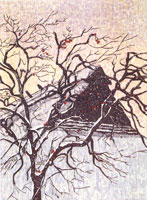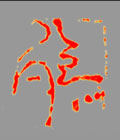 | | Snowy Morning 1987 / 100 / 55x40 cm | TOTAL IMMERSION The people of Japan regard Koizumi Yakumo as one of their own, Koizumi the family name of his wife assumed on change of citizenship, though abroad he is best remembered by his former name, which he retained as a writer in English - Lafcadio Hearn. Hearn’s retelling of Japanese gothic folk tales is the basis for his literary fame, through which readers abroad were introduced to quaint facets of life in this country.
Hearn’s feel for the Japanese psyche was total though, influenced by his own predilections, perhaps he may be faulted for depicting the Japanese of his day as too obsessed with things occult. So purple are his tales of the world of ghosts and spirits that one wonders if they might not all be partly responsible for misconceptions still given some coin today - that the Japanese are inscrutable and their ways mysterious.
...........(H)e finally became disillusioned with Japan,...... much of his dissatisfaction stemming from this country’s rapid industrialization. Yet such progress was inevitable; Japan, isolated from the world for so long, had a lot of catching up to do.
Still, one can sympathize. Ugliness came with that advancement; pollution and urban blight the unfortunate byproducts of each new machine. Smokestacks and jerrybuilt factories were to mar not only the landscape but also its ecological order.
Are the any Lafcadio Hearns in Japan today? I think so, rare the foreign resident who hasn’t come across somebody living as the Japanese and immersed in their yeasty culture. Not all are writers, they are found pursuing any number of fields; some studying zen or judo or ikebana or what-have-you though they do share one thing in common - an immense contentment at being here. However humble their circumstances, this satisfaction sustains them and, in turn, pervades whatever they do.
In the field of art Joshua Rome, an American, comes to mind. He and his Japanese wife live close to nature - on a mountainside overlooking Kyoto where, away from distractions, he creates woodblocks. Some may be familiar with his work, the College Womens’ Association of Japan having exhibited his prints in their annual shows.
Like Hearn, he came as a visitor and stayed, sating a fascination that appealed, in his case one that involved his hands, the crafting of Japanese woods into furniture. An apprenticeship under a Kyoto woodworker followed, his love of wood ultimately leading to the making of woodblock prints.
It is an ongoing, consuming passion. A decade has been spent in the hills of Kyoto where he continually hones his craft. This artist did not find Japan; Japan found the artist.
That the prints of this talented American reflect, both texturally and visually, the sensitivities of a fine Japanese artist is no anomaly. His rural scenes, his Kyoto rooftops breathe of the real stuff. Like Hearn in literature, Rome’s accomplishment in art is the result of total immersion. Yes, it has taken time and sacrifice, but to achieve authenticity allows for no other way.
MAINICHI NEWS PAPER June 22, 1984
from “On The Road with Joe Grace”
DIAMOND IN THE ROUGH Joshua Rome was born in New York City, the son of a Broadway composer and a novelist in 1953. Maybe it was bright lights and big city that taught him to love wild things - but a back road in the rice fields somewhere out in central Honshu seems a long way from the jungles of 5th Avenue in Manhattan. But then Rome is not your average New Yorker. He is a print maker now and a farmer ( the order’s not important ) - and the images he creates of the Japanese countryside are as direct and unpretentious, as genuine and instinctive as the artist himself. He paints what and where he lives - down the same secluded mountian roads, under the same thatched rooftops, with the same unvarnished farm folk always in the background.
Arriving in Kyoto in 1973, he began - without knowing it - to change his whole life. What started as a mild case of interest in a different culture (and a long time perchant for making things out of wood) turned into a lifetime pursuit. As an apprentice for three years to Kenkichi Kuroda, One of Kyoto’s most prominent craftsmen, he learned to respect the quirks and moods of wood, tampering with its limitations, tinkering with its possibilities. This led him to explore the use of a wide variety of Japanese hand- tools, including the type of chisels employid in making woodblock prints. As so often happens in Japan, what you look for is seldom what you find, and what you find is often yourself. For the first time ever, Rome found himself intrigued with the idea of color and line - and began making woodblock prints.
If Josh had stayed in the city, his work - and his life - would have turned out much differently. His move to a farmhouse surrounded by ricefields in the mountians North of Kyoto cvhanged more than his theme. Perhaps it was the isolation, perhaps the clean air and country living (he and his wife Michiko grow all their own vegetables) - no doubt his ricefarmer neighbors have given him far more than gardening advice - a glimpse of Japan at the core. Here in the countryside the traditional culture - undisturbed and undiluted - lives on.
Rome’s recent prints have a poignancy about them, a hint of “ pending doom”, as the artist himself only half-jokingly describes it. Even the remotest areas of Japan face development these days. One of the villages he portrayed in a series of prints last year has now been eaten alive by bulldozers to make way for a new dam. The gray drizzle of spring rain on thatched rooftops, the heavyness of snow on sagging eves, and the permanently bowed backs of the farm wives harvesting rice - in all thes images, his concern for the loss of a simpler way of life comes through clearly. He can do without the pavement , the machinery, and chemicals just as they did, and sometimes still do.
The paper on which he makes his prints is hand made washi from Echizen, one of the most famous papermaking towns in Japan. But beyond his knowledge of wood and fine materials - beyond even the importance of his subject matter - what distinguishes Rome from others who work in the same veinis the fact that his art only starts with such techniques and images, it doesn’t end there. His use of color and texture shows a sence of place far more intimate than the literal imagery that is his vehicle. Subdued undertones and blurred distinctions suggest what it really feels like to spend time, lots of time there.Life here is gray and rough-hewn, introspective and melancholy. You experience the cold of winter - and of isolation - in his work, not just the charm of a rural snow scene.
What’s New York about Joshua Rome? Perhaps his willingness to to try things. Just as with his subject matter, his traditional techniques are just a starting point. He breaks a lot of rules - some premeditated, some with the recklesness required to invent things. Rather than leaving the actual printing to an assistant as so many mordern printmakers do, Rome completes the whole process himself. “ I learn things that way,” he says. “Sometimes the biggest ‘mistakes’ turn out beautiful.” And even the oddest of paths can lead home.
by Diane Durston |



![]()
